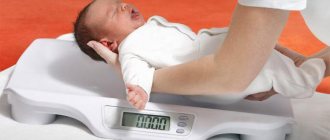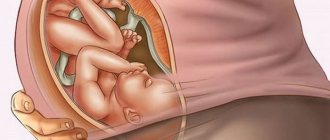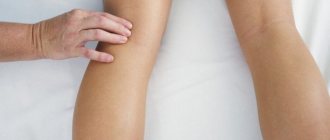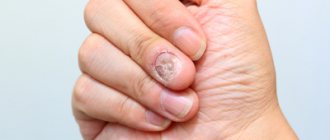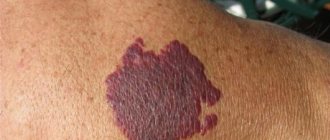The human body is a coherent system of all organs. A malfunction of even a small “part” of our mechanism can lead to a disruption in the operation of the rest. One of the symptoms of some problem in the body is swelling of the limbs. The process usually begins with the fingers of the hand, then moves to the entire hand. If you notice that the ring cannot be put on your finger in the morning, do not ignore the swelling. Observe, if everything is restored within a few hours, then you can calm down by figuring out the reasons yourself. Maybe you drank tea or compote before going to bed, or ate something spicy or salty. Try not to let this happen again and recheck the condition of your fingers the next day.
If everything happens again, it is better to consult a doctor for advice and identify the cause of what happened. However, if the swelling of your arm does not subside within a day, you should definitely see your doctor. Such processes are the first “bells” of serious disturbances in the functioning of internal organs - the liver, pancreas, kidneys, thyroid gland and even the heart.
In the article we will look at what swelling of the left arm and leg tells a person, what organs need to be checked so as not to miss the onset of a serious illness.
What is edema
Edema itself is not a disease. However, the appearance of stagnant processes in tissues tells the specialist about the presence of a disease. The causes of edema are due to impaired blood flow. A long period of stagnation of blood in the venous vessels causes hydrostatic pressure on the walls. In this case, the liquid is squeezed out, passing into the capillaries and tissues, filling the interstitial space. This is how swelling occurs. Let's consider the possible reasons why the left hand swells. Some of them are evidence of poor nutrition, while others report a problem with other organs and require an immediate solution to the problem.
How legs and arms swell
It is worth looking at the mechanism of edema from the pathophysiology. Tissue edema refers to excessive accumulation of water in the spaces between the cells that make up tissues and organs. Under normal conditions, there is a certain balance between the amount of fluid received and removed from the body. A disruption of this balance occurs in the following conditions.
When there is too much blood pressure inside the blood vessels, the water contained in it penetrates into the surrounding tissues, and its return has a slow process. This situation occurs primarily in patients suffering from arterial hypertension and heart failure.
A drop in blood oncotic pressure is associated with a deficiency of components that retain water inside the vessels, most often minerals and proteins. The accumulation of fluid in the tissues can lead to swelling. This problem often affects people with kidney disease.
Excessive expansion of the lumen of blood vessels and an increase in their permeability leads to edema. This condition occurs during any inflammatory processes, allergies or hypersensitivity.
Obstructed outflow of lymph from the lymphatic vessels and blood from the venous vessels leads to stagnation and accumulation of fluid inside the tissues.
How to recognize swelling
Swelling of the fingers or hand can be recognized by a simple visual inspection. Compare the left and right limbs by placing them side by side. The swelling is clearly visible to people who wear rings. It is impossible to remove jewelry in the morning or, conversely, to put on something that was removed at night. Another option for checking the appearance of swelling of a limb is to press your finger on the skin.
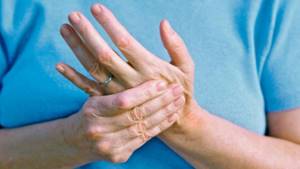
First, a white spot and dent appear, then the skin evens out within 30-60 seconds. If recovery takes much longer, this is a signal to urgently go to the doctor.
Swelling of the legs can be recognized either by comparison with another limb, or by putting on shoes that suddenly begin to press.
Problems with lymph drainage
If the intercellular fluid penetrates into the tissue, then tumors are guaranteed. Often this pathological phenomenon occurs against the background of long-term pharmacotherapy and mechanical damage (trauma).
In addition to this, swelling of the fingers may occur as a result of:
- helminthic infestation;
- bacterial damage;
- removal of lymph nodes.
You should also note that lymph stagnation often occurs due to exacerbation of chronic inflammatory diseases.
Causes of edema
The most common cause of swelling of the left hand is considered to be drinking too much liquid at night. They appear mainly on the fingers after sleep and disappear within a couple of hours. If this happens often, then don’t ignore it either.

Swelling of the fingers of the left hand may indicate an allergic reaction of the body. This may be skin contact with detergents, washing powder, or cosmetics. If you are taking medications, read the instructions carefully; the list of side effects may include swelling of the extremities.
Swelling of the hands may appear after drinking a lot of alcohol and overeating. If after another feast you notice that your left hand is swelling, then think about the right lifestyle, since the problem may concern the kidneys or liver.
Pregnant women often suffer from swelling of the left arm and leg, however, as well as the right limbs, swelling is especially visible in the last trimester, when the stomach is already large, the grown-up child puts pressure not only on other organs, but also on the blood vessels, increasing the pressure of fluid on neighboring tissues, which causes swelling. The legs swell from the pressure of the fetus in the uterus on the pelvic veins.
Nowadays, tight, leg-tight pants are in fashion. Wearing tight clothes can also cause swelling of the legs, since long-term compression of the veins leads to the release of excess fluid beyond the vessels into the tissue.
Limbs may swell before menstruation. Most often this happens 1 or 2 days before they start. This phenomenon is not observed in all women, but about 8% suffer from swelling of the hands during this period.
Swelling of the limbs and face
The cause of swelling of the arms and legs in 90% of cases lies in the improper functioning of the internal organs. People often blame the kidneys for not removing excess fluid from the body, which causes fluid stagnation, but this is not always true.
This condition can be caused by cardiac pathologies or abnormal production of hormones by the endocrine system.
Next, we will talk about how edema appears, what they are like, and what needs to be done to get rid of this unpleasant symptom.
Mechanism of edema development
Swelling of the arms and legs occurs when excess fluid begins to accumulate in the space between the cells. This process can affect the tissues of the entire body or a specific area.
Women often experience facial swelling after applying night creams or masks. This condition does not require drug treatment.
If your face swells without using any cosmetic products, then the problem is related to the functioning of the internal organs.
In a healthy person, a continuously certain amount of fluid enters the space between the cells and is then removed from them. If, due to external or internal natural factors, the balance is disturbed, then swelling of the face, hands or limbs occurs. A person who is faced with problems in the functioning of organs will experience swelling constantly.
Edema of the extremities
Many people face this type of pathology at the end of the working day. Swelling of the arms and legs indicates stagnation of blood in the body. They are usually observed in people who spend a lot of time in the same position. You should panic if you notice swelling in your arms or legs in the morning. This means that the outflow of fluid is seriously impaired. You need to see a doctor to
Swelling of the face
Swelling of the face can occur both due to natural causes and due to diseases of the internal organs.
Women encounter this phenomenon when changing cosmetics, excessively consuming food containing large amounts of salt and seasonings. This phenomenon is often observed a week before menstrual bleeding.
During this period, the body begins to accumulate fluid to compensate for blood loss.
Facial swelling is often accompanied by mild puffiness of the legs in diseases of the endocrine system. Swelling of the eyelids occurs due to problems with the urinary system. In this case, yellowish bruises may still appear. If, against the background of swelling of the face, the skin of the eyelids acquires a purple tint, then the cardiovascular system should be checked.
Main causes of swelling
The main cause of swelling of the arms and legs is simple physical fatigue. A person experiences stress at work, does not get enough sleep and cannot rest properly.
This ultimately leads to fluid accumulation in the extremities.
If this symptom does not leave a person even after a Saturday rest, then this is a reason to think that the appearance of swelling of the limbs and face provokes some kind of illness. The main causes of edema:
- heart problems;
- abnormalities in the structure of blood vessels;
- diseases of the urinary system;
- pregnancy time;
- diseases of the hepatobiliary system;
- complications after surgery;
- diseases of the endocrine system.
Cardiovascular diseases
Edema due to problems with the heart develops very specifically. Initially, the fingers and toes begin to swell, and then the entire length of the limbs is affected.
At first, the patient does not notice the pathology, but then begins to experience discomfort associated with the presence of excess fluid in the intercellular space. The cause of swelling of the arms and legs lies in poor myocardial function.
It can no longer pump blood in the required volume, so it accumulates in the vessels. This leads to partial dysfunction of the venous valves.
Diseases of the urinary system
A person often experiences swelling of the face and limbs due to problems with the kidneys. Excess fluid is not removed from the body. As a result, it begins to accumulate in the skin and fat layer. If the kidney system cannot function normally, then the patient's legs and face begin to swell first. Hands begin to suffer from the disease much later. The following ailments lead to edema:
- hydronephrosis;
- pyelonephritis;
- unspecified nephrotic syndrome;
- nonspecific nephritis;
- glomerulonephritis.
Vascular pathologies
Swelling of the legs and face can be observed when lymph stagnates in the vascular bed. This problem is often observed in women due to the peculiarities of the hormonal system.
Stagnation of blood in the extremities can occur due to varicose veins. The disease is accompanied by slow destruction of valves and loss of elasticity of vascular walls. The face and hands swell very rarely with vascular pathologies.
But with diabetes or atherosclerosis, this symptom may appear.
Pathologies of the hepatobiliary system
Edema in men and women can occur due to improper liver function. Fluid begins to accumulate in the body due to the fact that most of the protein begins to be washed out. The swelling spreads throughout the body and does not decrease over time.
Diseases of the hepatobiliary system can be chronic and acquired. Alcoholics suffer from the last group of diseases when they begin to abuse alcohol. The liver cannot cope with toxic substances, so protein synthesis is disrupted and fluid begins to be retained.
Ascites often occurs against the background of this pathology.
Endocrine system diseases
The endocrine system is responsible for the production of hormones. If it starts to work incorrectly, then a person may experience edema and other metabolic disorders. Pathologies of the endocrine system cause swelling of the torso and face. The limbs begin to swell as the disease progresses.
Pregnancy period
During pregnancy in the last trimester, many women experience swelling in the evening. This is due to the fact that due to the size of the baby, it is difficult for blood to return back to the heart.
In addition, sometimes, due to the special position of the child, the woman’s organs are partially compressed. As a result, normal blood flow is disrupted. Another cause of edema is pelvic varicose veins. It occurs quite rarely in pregnant women, because...
this disease is mostly hereditary in nature.
Additional reasons
As we mentioned earlier, abuse of various seasonings and salty foods can cause swelling of the face and entire body. This also includes drinking plenty of fluids before bed.
Thrombosis is often accompanied by swelling of the limb.
This disease requires specialized medical care, so if you find it in yourself, do not try to get rid of the swelling yourself, but go straight to the hospital.
Injuries and muscle strains often cause fluid stagnation. In the absence of excessive pain, this condition does not require additional treatment. At very high ambient temperatures, the body tries with all its might to normalize body temperature. Therefore, fluid begins to linger in the legs.
A separate category should include people who wear uncomfortable shoes and clothes. The reason for the appearance of edema with such an attitude towards one’s body is hidden in the long-term physical impact on the veins. This is dangerous because the vessels begin to stretch. As a result, the patient develops varicose veins.
Treatment options
Methods for treating swelling are varied. The choice of a specific method of normalizing fluid flow in the body depends on what caused the appearance of this unpleasant syndrome. Patients are prescribed various medications that normalize the functioning of internal organs. In case of thrombosis and other pathologies of the body that are not amenable to non-invasive treatment, a referral for surgery is given.
Drug treatment
The selection of medications is influenced by the initial cause of the fluid metabolism disorder. Kidney diseases are treated with drugs whose action is aimed at removing excess water from the body.
Diuretics are prescribed only in this case and for heart problems. If everything is in order with the main muscle of the body and the urinary system, medications of this type are not prescribed.
The following medications can be used to treat swelling:
- hormonal drugs if there are problems with the thyroid gland;
- venotonic medications if the patient is diagnosed with varicose veins;
- drugs with high protein content for liver problems;
- lymphatic drainage medications if vascular diseases are detected.
Surgery
There is no universal operation that will save the patient from swelling and return him to his former lightness in the body.
In case of heart problems, bypass surgery is performed or an artificial valve is installed in the patient. If the patient experiences thrombosis, the blood clot is removed.
In case of varicose veins, the affected vessels are eliminated. Before surgery, the patient always undergoes a full medical examination.
ethnoscience
Traditional medicine used to treat swelling helps remove excess fluid from the body, but they will not cure the cause of the disease. For this reason, doctors do not recommend taking decoctions and infusions of herbs until an official diagnosis is made.
Often, swelling is caused by pathologies of internal organs, which can be eliminated with medications or physiotherapeutic treatment. In such conditions, the use of traditional medicine can be harmful.
The following herbal preparations are especially popular:
- Green tea or hibiscus infusion. Both drinks are recommended to be consumed cold, because... When they are hot, they can cause an increase in blood pressure.
- Pharmacy renal fees. They are easy to use. Instructions for preparing such products are always supplied with them.
- Pumpkin juice. It is obtained from raw pumpkin. The juice speeds up metabolism and helps normalize kidney function. You need to use it 2 times a day.
- Infusion of yarrow. You can prepare it yourself by pouring 200 grams of dry raw material with 500 ml of vodka, and then leaving it for 10 days, or purchase a ready-made product at the pharmacy.
It is not necessary to drink any teas or infusions to improve the condition of swollen limbs and face. You can make a cabbage compress. First, the vegetable sheets should be beaten so that the juice comes out of them, and then applied to the swollen areas.
Secure the compress with cling film. It should be kept on the body all night. Similarly, you can use a mixture of olive and camphor oils. The ingredients are mixed in equal proportions and then applied to the feet.
First you need to bandage the limbs, and then fix the compress with cling film.
Must-have products
If you often experience swelling, you should change your diet a little. It is necessary to remove spicy, overly salty or sweet foods from the menu.
Sodas and alcoholic drinks will also not help you overcome your body's tendency to store fluid. You are allowed to drink only clean water in small quantities.
If you already have swelling, the following products will help you cope with it:
- apples;
- watermelon;
- dried apricots;
- buckwheat (without salt and seasonings);
- cucumbers;
- cranberry;
- different types of berries;
- eggplants (boiled or stewed);
- parsley;
- bell pepper
Physiotherapy
Swelling in the legs and face often appears due to a slower metabolism. Special exercises will help speed up metabolism, normalize blood flow, and help breakdown products leave the body faster.
The cycling exercise can be repeated an unlimited number of times throughout the day. Patients can do so-called toe gymnastics, i.e.
try to move objects with them or simply roll pencils.
It is recommended to perform the “Birch” exercise at least 2-3 times a day.
If it is physically difficult for you to take this position or your shoulder girdle and cervical spine are not flexible enough, you can simply throw your legs up on a hill and lie there for 10-20 minutes.
In general, when relaxing on a sofa or bed, try to stretch your legs, place them on a pillow or any other surface above the level of your heart. This will facilitate the flow of blood from your feet.
Prevention of edema
A healthy lifestyle will help prevent this unpleasant phenomenon. Always monitor the condition of your internal organs, eat fresh food rich in vitamins. It is especially important to monitor the water balance in the body. Swelling is often a consequence of insufficient water consumption, so drink 30 ml of liquid per 1 kg of weight per day.
Doctors recommend that people with a tendency to varicose veins and swelling wear compression garments. If the condition of the veins is relatively normal, knitwear with the first level of compression is suitable.
If the patient has varicose veins, then the type of underwear and the strength of the effect are determined by the doctor. Foot massage helps a lot in the fight against swelling. You can use ice cubes or specialized oil for it.
Baths with medicinal plants will help prevent the appearance of edema.
Source: https://venaz.ru/simptomy/oteki-ruk-i-nog
Bruises and injuries
The cause of swelling of the left arm may be bruises, bone cracks or fractures. After an injury, you need to place the limb on a hill and apply cold to the bruised area.

To do this, you can use ice from the refrigerator, just be sure to wrap it in a napkin or waffle towel. If after the night the sore spot is still swollen, consult a surgeon and take an x-ray to rule out a fracture. Injuries can also cause swelling of the left or right hand.
Edema due to excess weight
Another common cause of edema is considered to be extra pounds. Excess weight makes vigorous physical activity difficult and compresses blood vessels, creating stagnation of venous blood. To get rid of this problem, take your health seriously.

If you can’t lose weight on your own, seek help from an experienced nutritionist, stay on the move more, sign up for a fitness class or a gym. The trainer will select exercises for weight loss, blood will circulate better through the vessels, will not linger and put pressure on the walls. Thus, problems with swelling will go away on their own.
Causes
Swelling in the extremities in most cases is a clear symptom of a disease. Swelling appears in any season: winter, summer and spring-autumn. To get rid of it, it is necessary to identify the cause.
Poor circulation is the most common cause of edema . High pressure arising in the bloodstream squeezes fluid through the vascular walls into the interstitial space. In this case, it is absorbed back very slowly.
The provoking factors in this situation are two pathologies:
- hypertension;
- heart failure.
A similar problem occurs when there is a lack of substances that retain water in the bloodstream. Fluid accumulates in the interstitial space in patients with certain kidney diseases. The skin of patients is warm and pale.
With kidney disease, the upper parts of the body begin to swell first. The legs are finally swelling. Swelling that occurs in the morning disappears by evening.
There are other causes of swelling of the arms and legs; they are caused by:
- Endocrine diseases. Swelling often appears with hypothyroidism.
- Vascular pathologies. The limbs begin to swell in the evening. They are caused by intense physical activity. Swelling spreads unevenly. It can affect only one arm or leg, or limbs on one side, or both at once. With vascular diseases, the skin is cold and bluish.
- Pathologies of the hepatobiliary system are another reason why edema occurs. With them, protein is washed out of the body. Swelling affects the entire body and is chronic. The swelling practically does not disappear.
- Pregnancy. Swelling is caused by a change in hormonal levels in a woman’s body, compression of the venous vessels in the pelvic area, and poor circulation.
- Poor nutrition: consumption of excess salt, pickled, smoked, canned foods.
- Impaired drinking regime: water is consumed in excess or, conversely, in negligible volumes.
- Alcohol consumed in excessive quantities.
- Injuries: bruises, sprains, dislocations, fractures.
- High ambient temperature. Heat in summer contributes to the development of edema. When the sun is hot, they usually appear on the legs.
In the case of the feet, swelling occurs due to excessive physical activity and wearing uncomfortable shoes.
Chronic fatigue
In the morning you discovered that your left hand was swollen? What could this mean? Nervous stress, fatigue from long and tiring work, short sleep or insomnia, irregular nutrition, improper daily routine, where there is no alternation of work and rest. All this will ultimately lead to disruptions in the functioning of the body’s well-functioning system.

Stop! Think about your health! Change your daily routine, take a few days off, go to a resort and have a good rest. Try to organize proper, split meals, even have snacks at work. If swelling does not go away after rest, then consult a doctor and get examined. Maybe the cause of the disease lies in other organs.
Symptoms of serious illness
If the left arm swells greatly, this may indicate problems with the heart (after a stroke or heart attack), with lymphatic drainage, for example, after surgery. Immobilized hands often swell in paralyzed people.
If the area around the hand swells, this indicates compression of the subclavian vein. This large vessel tells about neurology, tumor or injury.
Swelling of the fingers of the left hand, which quickly spreads first to the hand and then rises all the way to the shoulder, indicates problems with metabolism and the removal of moisture by the kidneys.
Blood poisoning or an incipient abscess can also be accompanied by swelling of the hands.
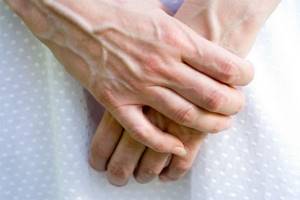
We list the main diseases that have swelling of the hands as a symptom:
- Phlebeurysm.
- Thrombosis.
- Arthritis or arthrosis.
- Polio.
- Syringomyelia.
Why arms and legs swell, treatment of swelling
All cells of the human body are saturated with water, it is also present in the extracellular space. Normally, a person maintains a physiological balance of fluid, but when its excess volume accumulates outside the cells, edema forms in the tissues.
They can be local, limited, or general in nature when tissues throughout the body swell. Swelling of the legs and arms is common, but few people pay attention to it, considering the symptom to be a situational phenomenon.
It is important to identify the causes of edema and find ways to treat individual pathologies in order to prevent their progression.
Swelling is often associated with poor drinking habits or an unbalanced diet. However, the problem may be much more serious, and indicate the development of pathological processes in different organs and systems of the body.
Heart problems
Swelling in people with heart failure is asymmetrical; swelling of the arms and legs is noted first from the fingers, gradually affecting the hands and shoulders, feet with ankles and shins. The skin is bluish and cold to the touch.
The patient suffers from shortness of breath, he is bothered by pressure surges and pain in the heart. Impaired blood flow impairs blood supply to internal organs, causing disruptions in their functioning, and swelling spreads throughout the body.
Most often in the evening the patient looks swollen.
Due to insufficient myocardial contractions and abnormalities in the functioning of the heart valves, blood is pumped inadequately. The vascular bed suffers from congestion, so excess fluid is removed into the extracellular space.
Problems with the urinary system
If the kidneys fail to remove fluid, it begins to accumulate in the fatty tissue under the skin. Swelling becomes noticeable on the face and in the lower extremities, and gradually the swelling also affects the arms. The problems are especially pronounced in the mornings, with “bags” appearing under the eyes. Patients are also bothered by nagging pain in the lumbar region.
Without treatment, the problem worsens, and a state of chronic renal failure may occur, and its exacerbation can lead to serious complications requiring immediate assistance. Therefore, if pathologies of the urinary system are detected at the initial stage of their development, it is necessary to immediately begin treatment.
Disorders that cause swelling of the arms and legs arise from:
- pyelonephritis, glomerulonephritis, nonspecific nephritis;
- pyonephrosis, hydronephrosis;
- renal oncopathology;
- nephrotic syndrome of unknown etiology.
Inflammatory processes of the urinary tract are also manifested by swelling of the extremities, although to a lesser extent than in conditions where the renal parenchyma is affected by serious pathology.
Endocrine disorders
Thyroid dysfunction can cause swelling in the arms and legs. Excess or lack of hormone production leads to disruption of metabolic processes, which results in swelling in the subcutaneous fat tissue.
For example, with hypothyroidism, constant tissue swelling is observed. Puffiness and pastiness are noticeable on the face, the upper limbs begin to swell, and then the lower ones.
Vascular disorders
The simultaneous appearance of edema of the arms and legs occurs in systemic pathology, when atherosclerotic changes are present in the vascular network. With diabetes mellitus, for example, vascular occlusions may appear in different parts of the body, that is, disruption of the patency of individual arteries and capillaries. Such conditions require consultation with an angiologist and a vascular surgeon.
One of the common problems is varicose veins, which results in swelling of the lower extremities. Women are more susceptible to pathologies of varicose veins.
They more often develop venous congestion due to a decrease in the firmness and elasticity of the veins, and disruption of the valves within the venous network.
As a result of poor blood flow, venous “stars” become noticeable in the lower extremities; by the end of the day, the legs swell, the legs and ankles become swollen.
Liver problems
Liver pathology often provokes fluid retention in the body.
Dystrophic changes in the liver parenchyma lead to disruption of its functions, which is why there is a deficiency of protein in the blood plasma, causing a decrease in the level of pressure in the blood vessels.
Therefore, the liquid is not retained in them and flows into the intercellular space, resulting in the formation of edema. Among the liver diseases that contribute to the occurrence of swelling:
- chronic hepatitis;
- cirrhosis;
- fatty tissue degeneration.
Anti-edema medications
The fight against chronic edema is carried out with the help of diuretics (diuretics), which have a different mechanism of action, and therefore differ in the strength and speed of action, and the duration of the positive effect. In therapeutic courses the following are prescribed:
- Potassium sparing drugs. They are gentle and can therefore be used by pregnant women. These are Veroshpiron, Eplerenone, Spironolactone.
- Drugs with a pronounced diuretic effect: Torasemide, Furosemide, Uregit, Lasix, Diacarb, Chlorthalidone.
- Diuretics that increase blood flow: Mannitol, Mannitol, Urea. Not used in cases of liver and kidney dysfunction.
- Cardioprotectors: Riboxin, Riboflavin, Mildronate.
Medicines (ointments, gels) with a decongestant effect are used externally.
Folk remedies
A rich arsenal of folk remedies qualitatively complements the main treatment: removes excess fluid, eliminates pain and discomfort.
Recommended to drink:
- rosehip infusion;
- tea from hibiscus, linden, thyme;
- decoctions from a collection of herbs with bearberry, horsetail, corn silk, lovage.
It is useful to apply compresses with fresh cabbage leaves, raw grated potatoes, and aloe pulp.
Danger signals
A doctor’s consultation and a serious examination of internal organs are urgently required if:
- The swelling is one-sided, for example, only the left arm swells.
- In addition to the extremities, swelling appears on the neck, eyelids or legs.
- Asymmetrical swelling indicates the presence of pathology.
- The swelling does not subside for a long time during the day.
- When pressing, the dent on the swollen limb is restored in a few minutes.
The presence of at least one of the listed symptoms should alert a person. Without putting off going to the doctor for too long, make an appointment. A phlebologist deals with edema.
Diagnosis and treatment
After visiting a doctor, you need to undergo diagnostics of internal organs, take basic blood and urine tests. The lungs are checked, and women may be referred for consultation to a mammologist.
To help moisture leave the body faster, diuretics are prescribed. However, diuretics have the ability to remove potassium from the body, so the doctor must prescribe potassium supplements to replenish the loss.
If you have problems with the veins, you need to select compression pads with your doctor that will support the vascular structure.
The use of ointments or medicinal gels will help with swelling of the left hand.
It is imperative to treat the underlying disease. It is also necessary to reduce fluid intake; this includes not only water, but also tea, coffee, soups, juicy fruits and vegetables. The last fluid intake should be at least 3 hours before going to bed. Do not eat spicy or salty foods, completely avoid alcoholic beverages and foods that contain alcohol.

It is necessary to normalize the alternation of work and rest, not lift heavy objects, and give the hands the least amount of stress. Rest more, don't be nervous, sleep at least 8 hours.
Where does swelling come from?
Here are the most common reasons.
You have been injured or burned
A deep scratch, a bee sting, a sprained ankle, a burn - any injury that affects the inner layers of the skin is considered dangerous by our body. And he reacts to it with swelling. The more fluid from the blood vessels in the area of injury, the more white blood cells there are that can fight a possible infection.
Are you drinking too much or too little?
In the first case, the kidneys do not have time to remove excess fluid from the body. A lot of water accumulates in the blood plasma and is squeezed out through the walls of blood vessels.
In the second, when there is a catastrophic lack of fluid, the body begins to make reserves in the intercellular space. Therefore, swelling often appears in the heat. They are a signal that you are approaching dehydration.
By the way, large doses of alcohol also provoke a lack of fluid. With corresponding “swollen” consequences in the morning.
You ate a lot of salty foods
Normally, excess fluid from the intercellular space goes back to where it came from: it returns to the vascular system. But salt retains water in the tissues. As a result, love for salted fish or pickled cucumbers often results in swelling.
By the way, hyaluronic acid, which is used in anti-aging beauty injections, has the same moisture-retaining effect. If you overdo it with injections, you can end up with a swollen face instead of a youthful one.
You are on a low protein diet
If the body lacks proteins, its tissues, including the walls of blood vessels, become less elastic and more easily allow moisture to pass into the intercellular space. Therefore, the cause of swelling can also be vegetable or fruit fasting days, which are popular in summer.
You have been in one position for too long
We mentioned the connection between stagnation of blood circulation and swelling above. This type of swelling most often affects the legs—for example, if you've been standing or sitting for too long—and the arms, if they've been in an awkward position.
You are a woman and you have PMS
Hormonal fluctuations during premenstrual syndrome are often accompanied by the accumulation and retention of fluid in the tissues.
You are pregnant
As in the previous case, hormonal fluctuations are to blame. The same reason applies if you are approaching menopause or taking oral contraceptives.
You are taking certain medications
Swelling can be a side effect of even seemingly innocent drugs:
- popular painkillers, such as ibuprofen or naproxen;
- medications for high blood pressure;
- some drugs used for diabetes;
- steroids.
Exercise stress
For edema, active movement is recommended. Warming up the muscles will lead to better blood circulation in the vessels, which will prevent the formation of swelling in the hands. The load should not be too heavy; exercise in the morning and two hours before bed, as well as long walks during the day, will be enough.

Swimming is good for promoting good blood flow. Keep your muscles in proper tone and you will soon forget about swelling. Massaging your hands and fingers helps a lot. Movements should be gentle, using the pads of your fingers.
fingers are swollen, what to do if your fingers are swollen
Swollen fingers are usually harmless, but sometimes sausage hands signal something more. The medical point of view is expressed by Rekha Kumar, MD, Associate Professor of Medicine and Member of the Preventive Medical Examining Board (USA, New York).
You have arthritis pain, and the inflammation in your joints causes your fingers to swell and look like little sausages. Or maybe you ate a salty meal and now your wedding ring is stuck on your finger.
Should I worry? Probably no. Fingers become swollen for many reasons, and many of them are harmless. But sometimes swelling, known medically as dactylitis, indicates more serious health problems. Here are some of the common causes of swollen fingers when you should go to your doctor.
Why do fingers and toes swell?
1. It's very hot outside.
Heat causes blood vessels to dilate, allowing more heat to escape through the skin. As a result, body temperature decreases. When blood vessels stretch, some of their fluid can leak into your soft tissue and cause swelling.
This type of swelling usually goes away when you use your hands in your normal activities. But if you notice swelling only in your hands and fingers (and not your feet), accompanied by pain or weak grip, it may be a sign that it is not from the heat and you should consult your doctor.
2. You eat too much salt.
Chicken, a lot of chips or anything fried can also cause your swollen fingers. Your body likes to maintain a constant balance between salt and water, so when you increase your sodium intake, it compensates by retaining more water and, as a result, causes swelling.
More often than not, mild swelling caused by salty foods will go away on its own within a day, but it may last longer depending on how much salt you have in your body. If you reduce the amount of salt and the swelling does not go away, contact your doctor.
3. You may have osteoarthritis or rheumatoid arthritis
If the bony knuckles themselves are enlarged (say, you can't get rings on your knuckles), osteoarthritis could be to blame, especially if your swollen fingers appear in the morning. This age-related form of arthritis is caused by wear and tear of the shock-absorbing tissues at the ends of the joints. Osteoarthritis is often, but not always, accompanied by pain and stiffness.
Rheumatoid arthritis (RA), an autoimmune disease that affects the lining of the joints, can also cause swelling. Unlike osteoarthritis, RA is not age-related and can affect anyone at any age. Swelling in people with RA often occurs in the wrists and finger joints.
4. Infection or injury may be to blame.
Infections in your fingers cause your fingers (especially around the tip or nail) to fill with pus.
Infections can occur in different ways. For example: washing dishes without gloves, manicuring, ingrown nails, hangnails and nail biting can introduce bacteria into the fingers and lead to swelling, redness and throbbing pain. Minor injuries such as cuts, puncture wounds and shrapnel can also have similar effects.
If an infection is detected early, it can be treated with warm water or saline and antibiotic ointment, but if you experience severe pain, have difficulty using your finger, or notice pus, see your doctor as soon as possible. He will prescribe oral antibiotics if necessary.
5. It could be a side effect of your intense workout.
During exercise, your fingers and hands may swell slightly as the blood vessels in your body respond to the increased energy demands of your muscles. The vascular system responds by releasing more fluid. This is how the body cools down.
6. Swollen fingers - your medications may be the cause.
Some medications can also cause swelling in the fingers and hands. High blood pressure medications, over-the-counter pain relievers, diabetes medications, steroids, and birth control pills can cause swelling as a common side effect.
7. You May Be Dealing with Carpal Tunnel Syndrome
When the nerve that runs from the forearm to the palm becomes pinched or compressed in the wrist, carpal tunnel syndrome occurs, which women are three times more likely to develop than men.
Carpal tunnel syndrome can lead to swollen fingers and is usually accompanied by pain, burning, tingling or numbness in the hands—symptoms that often develop slowly over time. To prevent and relieve carpal tunnel syndrome, do stretches (exercises) at your desk.
8. Pregnancy can ruin your body.
Some swelling is typical for expectant mothers. But swelling in the hands and face, especially if pressing your thumb into the skin leaves noticeable indentations, can be a sign of preeclampsia, a complication characterized by high blood pressure.
If preeclampsia is left untreated, it can cause damage to organs, including the liver and kidneys.
In addition to swelling, signs of preeclampsia include blurred vision, high protein in the urine, headaches, nausea and vomiting.
The risk of preeclampsia is highest in pregnant women over 40 or those who are having their first child. It is also common in women who have twins or triplets and those who are obese.
9. You may have Raynaud's disease
Raynaud's disease is a rare condition characterized by narrowing of the arteries and restriction of blood circulation. The reasons for this are not fully understood, but cold temperatures, stress, hand injuries, tissue damage, and even certain medications (such as those for high blood pressure or migraines) can be causes. This disease is more common in women than in men.
When the "attack" begins, your fingers may first turn ghostly white, but other parts of your body may also be affected, such as your nose, lips, or ears. When circulation is restored (you become warm or your tension subsides), along with numbness, tingling, pain or changes in skin color, swelling occurs, most often in the fingers and toes.
10. Unidentified, hidden kidney problems
If your kidneys are unable to remove excess fluid, the fluid remains inside you. Swelling can affect any part of your body, but swelling most often occurs in the hands, feet, legs, and ankles.
The kidneys also help regulate electrolytes in our body. Therefore, any type of kidney disease can affect this process.
Hypertension and diabetes are some diseases that can cause kidney problems.
11. It could be a blockage in your lymphatic system.
Lymphedema is a rare swelling of the limbs that occurs when the lymph fluid (which removes waste, bacteria and viruses from the body) is not sufficiently cleared. Your fingers and toes, your arms and legs will swell.
According to a report from the National Cancer Institute, your skin may feel tight or thicker than usual with this disease. Lymphedema has been associated with surgery or radiation treatment for breast cancer. In rare cases, lymphedema is also caused by abnormal tumor growth near a lymph node or vessel, which can lead to a fluid blockage.
If you found this page interesting, share the link to it with your colleagues and friends by clicking on one of the buttons below. Surely someone will be grateful to you. You may also be interested in:
Source: https://woman-21vek.ru/zdorove/obshhaya-terapiya/11-prichin-po-kotoryim-raspuhli-paltsyi-ruki-nogi.html
Water treatments
If your fingers are swollen, contrast baths will help cope with the problem. The sharp change in water temperature improves blood circulation through the vessels, which will relieve the veins of stagnation.

You can use a full body contrast shower. First warm up your body and then turn on the cold water. Repeat this several times, and then rub your body well with a terry towel.
During the treatment of swelling of the left hand, it is recommended to visit a sauna or Russian bath at least once a week, combining the temperature contrast with excellent cleansing of the skin pores and sweat ducts.
Salt baths for both the hands and the whole body will help cope with swelling. The temperature should be 42-45 degrees, no less. For a full bath you need to add 300 grams of sea salt. It is recommended to lie in salt water for no more than 30 minutes.
How to react
Of course, this is not a complete list of possible sources of swelling. The problem can arise due to decreased protein levels, vitamin deficiency, pregnancy, hormonal imbalance and a million other reasons. That is why, if swelling appears, you need to consult a doctor and, if necessary, begin timely treatment.
What you can do yourself, at home:
- change your diet (remove salt, fast carbohydrates);
- to refuse from bad habits;
- avoid contact with allergens;
- normalize blood circulation;
- perform self-massage and special gymnastics.
Drug treatment is prescribed by a specialist based on diagnostic results. Most often, physiotherapy (electrophoresis, UHF), the use of external agents (ointments, gels) and taking medications with a diuretic effect are recommended.
Traditional methods of treating edema
- Pumpkin juice. Squeeze it using a juicer and drink one glass of fresh juice per day for a month.
- Caraway seeds are poured with hot water in the following proportion: per 1 tbsp. liquid - 2-3 teaspoons of seeds. Let it sit for a couple of hours, then drink little by little throughout the day. Treatment lasts one week, then a break is needed.
- Boil one teaspoon of pine buds in a glass of water for 15 minutes, then the solution should sit for a couple of hours. Drink in small portions one day.
- One tbsp. pour a spoonful of cherry stalks into a glass of boiling water and boil everything for 15 minutes. Drink one third of a glass 3-4 times a day. It is advisable to brew fresh decoction daily.
- 4 teaspoons of flax seed are poured into a liter of water in an enamel container. After boiling, cook for 5 minutes. And after removing from the heat, cover with a thick towel or blanket. Thus, the tincture is gradually cooled over several hours. You need to drink half a glass every 2 hours, after straining through several layers of gauze. You can add a slice of lemon for taste.
- Take equal parts of herbs - nettle, St. John's wort, plantain and bearberry, for example, 1 tbsp. l., and mix in a bowl. Then one tablespoon of the mixture (it’s better to finely grind the herbs) is poured with 600 ml of water. Place the bowl on the fire and after boiling, boil for 5 minutes. Then everything is infused at room temperature for 1 hour and filtered through cheesecloth or a fine sieve before use. You need to drink the decoction in one day in several doses.
With the right treatment, swelling will disappear quickly. It is only necessary to undergo an examination to exclude serious diseases of the internal organs. Be healthy!
Swelling of the arms and legs
Swelling of the legs and arms has bothered everyone at least once in their life. Our body consists of 80% water, and if internal organs do not function properly or physical activity is uneven, it stagnates in the intercellular space of tissues: edema forms.
The simplest way to determine is by palpation: we press on the skin on the back of the foot or hand. If a pit forms (after some time the pit disappears), the color of the epidermis at the point of pressure sharply turns pale - this is edema.
With an upward movement along the outer part of the limb, you can feel the boundaries of the edema.
Types of edema
Edema occurs:
– episodic or irregular (spent the whole day on your feet, sat for a long time without getting up, uncomfortable shoes, excess weight, very hot weather, which aggravates the occurrence of swelling). By eliminating or easing adverse effects, we get rid of the problem!
– chronic or regular (pasty occurs constantly, appears both in the morning and in the evening). Here, delay, traditional methods of treatment and self-prescribed medications are categorically inappropriate and even dangerous! Only consultation with a competent specialist will solve the problem and alleviate your condition.
Why does swelling occur?
The main causes of chronic edema:
1. Diseases of the cardiovascular system
“Cardiac” edema is asymmetrical and occurs in the evening. The skin is cold, bluish in color, and when pressed, a dimple forms, which slowly smoothes out. Swelling can occur not only in the legs, but throughout the entire body; its occurrence is often attributed to excessive physical activity. If stress is excluded, but swelling continues: don’t be lazy - go to the doctor for a consultation!
2.Diseases of the kidneys and genitourinary system
The swelling is symmetrical and localized in the upper part of the body; without treatment, it can affect the legs and occurs in the morning. The swelling is mobile and moves when pressed. The patient is bothered by lower back pain and bags under the eyes.
3. Disturbances in the functioning of the endocrine system
When hormonal levels change, swelling affects the face and upper body, and if the disease worsens, it affects the legs.
4.Vascular diseases (impaired venous outflow)
Swelling appears in the evening and worsens with physical activity. The network of venous vessels is clearly visible on the legs, the ankles of the legs swell, but not the fingers, and painful cramps are possible.
5.Irregularities in the functioning of the lymphatic system.
Swelling of the legs, when the lymphatic flow is disrupted, is very dense, painful, and constantly increasing. It is impossible to get rid of them on your own.
6. Edema during pregnancy.
Although pregnancy is not a disease, you should consult a doctor if swollen legs are your permanent condition. It is very important to distinguish between physiological swelling during pregnancy and pathological! This can signal a problem with kidney function, heart problems and a host of other equally serious problems!
With the correct diagnosis and identification of the root cause of swelling, complex treatment (medicines and exercise) gives a positive result and relieves the problem for a long time.
Exercises to combat swelling
To alleviate and relieve swelling, special exercises are good - shifting pencils with your toes, rolling a tennis ball, rolling your foot from heel to toe, the “bicycle” exercise - you can repeat them as many times as you like throughout the day.
Simple steps improve blood and lymph flow in the legs and help get rid of swelling.
It’s great to lie down for at least 20 minutes with your legs raised up or do a “birch” (we raise the body and limbs high) this way we promote the outflow of fluid from the lower part of the body.
Compression stockings (socks, tights) will be very useful not only for pregnant women, but also for those who walk a lot, stand still or sit for a long time. These wonderful knitted products properly distribute lymph flow and blood circulation in the limbs and prevent swelling.
Massage of the feet and legs will help relieve swelling; it is very good to do it with frozen ice cubes, and complete the procedure with contrasting or regular baths. You can add 2 tbsp sea salt to the water. per liter of water or herbal decoction (mix birch leaves, chamomile inflorescences and mint in equal proportions).
Drug treatment of edema
In the drug treatment of chronic edema, strong diuretics (diuretics) are prescribed, with different mechanisms of action and effectiveness (speed, duration or strength of action).
The most popular drugs:
- torasemide, veroshpiron, lasix, tripas, hypothiazide, diacarb, chlorthalidone, furosemide - saluretics (increase the excretion of NaCl ions, roughly speaking, salt that retains water in the body);
- veroshpiron, spironolactone, amloride - diuretics that do not remove potassium;
- urea, mannitol, monitol are osmotic diuretics (they increase the volume of circulating blood; they are not prescribed to patients with renal or liver failure).
All drugs are potent, have a large list of contraindications, only a doctor can choose the optimal drug!
Folk remedies against edema
In the fight against episodic edema, compresses and remedies from the arsenal of traditional medicine will help us.
They have an excellent diuretic effect:
- cold green tea;
- Sudanese rose (hibiscus) tea, if drunk hot, increases blood pressure;
- rosehip decoction, which is also rich in vitamin C (1/2 cup of dried fruits per 1 liter of water - after boiling, simmer over low heat for 20 minutes);
- a decoction of thyme and linden inflorescences (2 tablespoons in a 1:1 ratio per 250 ml of water, bring to a boil in a water bath and leave for 30 minutes);
- tea from bearberry, horsetail and lingonberry leaves (pour 1.5 tbsp in a 1:1:1 ratio into a thermos, pour into a glass and leave for 3 hours);
- decoction of flax seeds 1 tbsp. for 200 ml of water, cook in a water bath for 10 minutes;
- Pharmacy kidney mixtures (orthosiphon stamen) or the drug Nephrofit (ready-made packaged collection of herbs) - brew according to the instructions on the package.
We remind you that even herbs should not be abused, if relief does not occur after several doses, consult a doctor!
Products that remove excess fluid
The food basket of a sufferer from swelling must necessarily contain:
- watermelons - this juicy miracle berry will remove excess water from the body effortlessly;
- buckwheat – boiled without salt or other additives, an excellent helper in the fight against swelling and an ideal dinner;
- apples – improve digestion, reduce cholesterol in the blood and remove excess fluid from the body;
- berries - raspberries, strawberries, strawberries, cherries - small treasures of all kinds of vitamins, help cope with external and internal swelling;
- bell pepper is a well-known vegetable, rich in potassium and magnesium, removes excess salt, and at the same time toxins;
- cucumbers - incredibly, help cope even with “cardiac” edema, the main thing is to consume them without salt and seasonings;
- parsley is the leader among greens in terms of diuretic action - generously season the pepper and cucumber salad with it;
- eggplants (blue) - great for helping with swelling, but only when boiled or stewed;
- dried apricots are a very strong diuretic, especially an infusion or compote made from it, so hypotensive patients, allergy sufferers and asthmatics should use it with caution;
- cranberry - a fruit drink made from fresh or compote from dried berries is recommended even for pregnant women in the fight against edema; it will also be useful for you, just do not sweeten the drink.
In the heat, pay attention to your diet: exclude spicy and salty foods, alcoholic drinks, carbonated drinks.
We drink more clean water, which we drink little and often! We put on comfortable, light shoes without high heels, but not flat ones either, ideally orthopedic ones.
Clothes should not be too tight or too tight anywhere - we say “no” to bandage dresses, tight jeans and corsets!
Listen to your body, follow simple recommendations and your legs will delight you with lightness and beauty! Swelling of the Legs, Swelling of the Arms
Source: https://iwoman.club/zdorovie/zdorovoe-telo/oteki-ruk-i-nog
